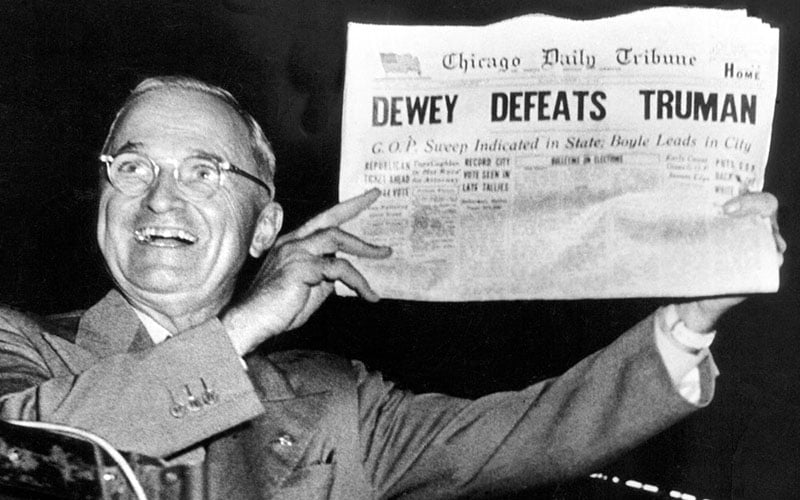
This was not the first election where polls got it wrong, as this 1948 photo of President Harry Truman’s re-election shows. But large numbers of polls were off the mark this year, incorrectly predicting Hillary Clinton would beat Donald Trump. (Photo courtesy Internet Archives Blog)
WASHINGTON – Marty Wheeler never did trust those polls.
The 50-year-old Sun City resident and Donald Trump supporter said he saw stronger support for the Republican presidential nominee than the media reported, which cited polls predicting a Trump loss to Democrat Hillary Clinton.
“Trump far outnumbers the Hillary support, yet when it comes to the polls that are for Hillary, that kind of doesn’t make sense to me,” Wheeler said just days before the election.
As the world now knows, Wheeler was right, and the polls got it wrong.
Trump, now the president-elect, claimed throughout his campaign that polls did not reflect the wide support he held among the white working-class Americans who often packed his rallies.
“The media refuses to talk about the three new national polls that have me in first place. Biggest crowds ever – watch what happens!” Trump tweeted Oct. 21, a day after a poll commissioned by the Arizona Republic and Cronkite News reported Clinton up by five points in Arizona – where 20 percent of those surveyed were undecided.
It was one of a number of polls at the time that showed the race tightening in Arizona and that Trump, nationally, had increasingly slim chances of moving into the White House.
Experts say several factors that combined to make Wheeler look smarter than the pollsters. One is the tendency by the media and the public to accept poll findings as hard facts and not shifting predictions. But the bigger problem is the near impossibility of predicting who will actually cast a ballot.
“You need much more predictive modeling that probably doesn’t exist with great sophistication,” said Maurice Tamman, a data journalist for the Reuters news service.
Because polling is based on informed predictions of who will show up on Election Day, those predictions impact a poll’s confidence and its forecasts.
“If you can’t predict (voter turnout) with the same empiricism, then it’s left to the subjective choices of pollsters,” Tamman said. “You make those choices, and then Election Day comes around, then guess what … an upset, and the polls are all wrong.”
A Nov. 8 story by Tamman ran under the headline, “Clinton has 90 percent chance of winning.” It was among a number of reports giving Clinton a 75 to 99 percent chance of winning – but it also spelled out a possible path to victory for Trump.
“Now, I look at it, and I cringe,” he said. “You make certain assumptions about demographic turnout. We as journalists have to stop presenting these numbers as absolute. Let’s stop viewing things as absolutes.”
Headline aside, the Trump-victory path described in the article was almost exactly the scenario that unfolded Tuesday.
“No one really knows who the hell is going to show up on election days,” Tamman said. “Ultimately who shows up is anybody’s guess.”
He said low voter turnout tends to benefit Republican candidates; higher voter turnout historically benefits Democrats. That, at least, held true: While Clinton won the popular vote Tuesday, she earned 7 million fewer votes than President Barack Obama did in his 2012 re-election, Tamman said. Republican challenger Mitt Romney garnered more votes in that election than were cast for Trump this week.
In Arizona, voter turnout models were easier to predict, said Republican pollster George Khalaf. His firm and most other polls had Trump up in the state, heading into Election Day.
Khalaf said Arizona did not see the demographic and turnout shifts that pollsters missed in other states – Michigan, Wisconsin and Pennsylvania. And Arizona proved to be more competitive than it was in the past two elections, with Trump beating Clinton by just 4.1 percentage points. That’s less than half the margin earned by Republican nominees Mitt Romney in 2012 or John McCain in 2008.
Many national polls misjudged the number of Democratic Rust Belt state voters who cast ballots for Trump, or the elevated number of white men who voted, or the drop in minority voter turnout from the levels that came out for Obama. Many national pollsters got the turnout models wrong in some key states.
Besides pollsters needing to better outline their underlying models, journalists must better report those judgments so voters understand how polling data can be used, the experts say.
If pollsters and reporters better communicate what the polls report, and the assumptions that are rooted in informed conjecture, fewer people may be surprised the next time the predicted outcomes are wrong.
“That’s not a problem with the polls, that’s a problem with judgment behind the scenes, and if that’s what happened here with polling (this election cycle), then that’s fine,” Khalaf said.
In the wake of this election, the American Association for Public Opinion Research plans to review those judgments that led to the misfire in nation polls.
“There’s always the danger that they’ll get things wrong. That’s a known source of error going into the process,” said AAPOR’s Vice President Tim Johnson. “It’s imperfect. We have to rely on imperfect models, and sample surveys are imperfect.”
The study plans to review election cycle methodologies for any potential systematic errors pollsters made, to make the surveys more reliable in the future.
“There were so many all pointing in that direction, we were all certain they were right,” Johnson said. “It’s embarrassing.”
As for Wheeler, he said he was not going to let the polls decide the election, and they did not.
“From the beginning, I have been encouraging everybody to vote. It doesn’t matter who they vote for, it is most important that no matter what the polls say, they need to vote,” he said.